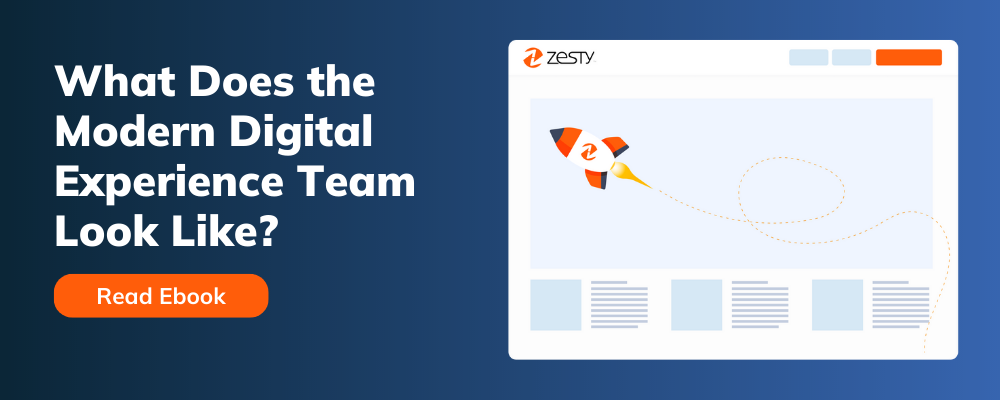Sitecore, a popular monolith in the digital experience platform (DXP) space, is swapping its legacy, monolithic approach to web content management, and is adopting what appears to be a composable, API-first ecosystem. At least that’s what the latest announcement indicates.
More than anything, this proves that migrating to a modular DXP is the sure-fire way to future-proof your content offering. Likewise, Gartner affirms that the future of enterprise applications is composable.
Sitecore DXP Transition Proves Monoliths Are No Longer Fit For Purpose
Enterprises need a solution that’ll give them maximum flexibility to meet present and future demands, and monoliths can no longer suffice. For a modern enterprise seeking to be fully agile, digitally savvy, and able to create engaging customer journeys, using monolithic platforms brings out a range of issues that can be severely limiting or even damaging to a modern enterprise.
Let’s take a look at some of these problems:
- Greater complexity: Monoliths come with too many jumbled parts that don’t necessarily work well together. These mismatched parts lead to a higher degree of complexity for your developers and marketers. Besides, it can be very difficult to manage without platform experts, which means you’ll need to take time to learn about the platform.
- Rigid architecture: With the growing tech ecosystem, monolithic platforms are not agile enough to adapt or respond quickly to customer needs. This puts your company at a disadvantage, potentially losing customers and revenue to your competitors.
- Limited scalability: Having a traditional DXP such as Sitecore makes it extremely challenging to scale up or scale down your tech stack. Integrations with third-party solutions are not as seamless since they are not composable API-first solutions.
- Longer time to market: When you consider a monolith's complex architecture and steep learning curve, it wouldn’t come as a surprise that it takes longer to develop sites, migrate to newer versions, and add new features.
- Poor omnichannel support: With customers spread out across different apps or media platforms, failing to deliver consistent omnichannel web experiences can be detrimental to your business. That means you won’t be able to scale and serve content to the modern innovative channels, such as digital assistance, digital signage, AR/VR, etc.
- Security failure: Monolithic systems have a wider blast radius when it comes to service failure. This means that one failure in a single service can cause the whole house of bricks to fall apart.
Still Using a Monolithic DXP? Here’s What You’re Missing
For enterprises still relying on monolithic DXPs, you are missing out on a ton of benefits by not leveraging a composable DXP like Zesty.io. Some of these benefits include:
Seamless Integrations With Best of Breed MACH Solutions
Building your tech stack with the right solutions is a good way to ensure success—and one way to do that is to choose best-of-breed solutions that follow the principles of MACH architecture. These principles help you select and integrate microservices-based, modular, and flexible solutions that will future-proof your tech stack, ensuring you can adapt easily to any market needs.
Scalability Without Limits
Consistent success cannot be possible without the right foundation for scaling your technologies. Composable DXPs enable you to scale your tech stack up or down according to your needs. You can easily add or remove any solution as you see fit without breaking existing infrastructure.
Faster Time to Market
Since composable DXPs enable you to take advantage of modular microservice-based solutions, you can always rely on solutions that are easy to use, developer and marketer-friendly, and highly effective. Building your tech stack with a composable DXP ensures faster development, automated upgrades, seamless integrations, and customer-centric experiences.
Omnichannel Delivery
‘Build once and deliver everywhere’ is a guiding principle for ensuring brand consistency across all channels. Composable DXPs help to future-proof your tech stack, ensuring you’re always ready to build and deliver consistent digital experiences to any channel or device, such as websites, email, mobile apps, digital assistants, and IoT-enabled devices.
Customer-Centric Digital Experience
Customer experience is an increasingly vital element in any business. Having composable DXPs enable you to tailor experiences to each customer through API-first, AI-powered, analytics, and personalization functionalities. You’ll be able to adapt to current and future customer demands and deliver omnichannel experiences.
Zesty.io: Start Building Your Composable Digital Experience Platform
Recent Sitecore acquisitions demonstrate that the future of DXP is composable. However, Sitecore’s journey toward full composability will still take time due to its underlying monolithic architecture. Continuing with these monoliths will inevitably place your company behind your competitors, negatively impact customer experiences, and limit future growth.
Thankfully, there’s hope; you can easily migrate to a MACH-powered, API-first composable DXP by leveraging Zesty.io. Zesty.io is a hybrid headless CMS with the full power of WebEngine to build complete sites, ensure consistent omnichannel delivery, developer/marketer-friendly, and most importantly serve as the basis to build your DXP by integrating easily with other best of breed solutions.
